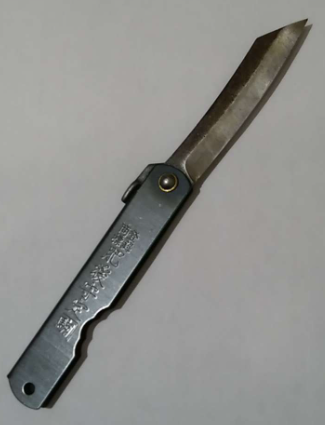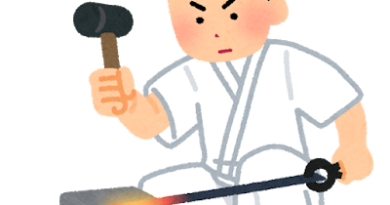Simple Japanese All-Purpose Knife – Higonokami
Popular outdoor knives in Japan were mainly products from outside Japan. Popular outdoor knives include Sweden’s Mora Knife and France’s Opinel knife.
In recent years, however, there is a Japanese-made outdoor knife that has been attracting renewed attention. That is the Higonokami.
Higonokami knives were used daily by elderly Japanese people as children for pencil sharpeners, crafts, and other purposes. However, since knives are now considered dangerous, they are rarely seen in modern Japan.
In the meantime, the French magazine “PANORAMA” featured Higonokami knives in 2012, which brought Higonokami back into the spotlight worldwide.
Not only do people collect these knives with nostalgia, but they are also reputed to be highly functional all-purpose knives that can still be used today. More and more people in Japan are using them for camping and other activities.
Table of Contents
Features of Higonokami
Higonokami has the following features:
- Manufactured since the 1890s
- Folding Knife
- No locking mechanism
- Simple construction makes it inexpensive and long-lasting.
Isn’t it dangerous without a locking mechanism?
Before I purchased the knife, I was concerned that a knife without a locking mechanism might be dangerous. However, after actually using the knife, I found it to be surprisingly safe.
The resistance when moving the blade is just right, and it does not fold under its own weight. It may become loose after continued use, but it can be re-tightened by tapping the swage lightly with a hammer.
If you hold the “chikiri,” a protrusion on the back of the blade, with your thumb, you can avoid unintentionally folding the blade and cutting your finger. If you use it in such a way that you stick the tip in, you may cut your finger, but it is not meant to be used that way, nor should it be used that way.
Advantages and disadvantages compared to other outdoor knives
What makes the Higonokami better than many other knives is its sharpness. Depending on the type of material, the sharpness when sharpened is outstanding.
Higonokami vs. Mora Knife
The Swedish Mora Knife is very similar to the Higonokami knife in use.
The main difference between the Mora Knife and the Higonokami is its foldability. The ability to fold up compactly without a case and store it in a pocket is a major advantage of the Higonokami.
However, when it comes to grip, the Mora Knife seems to be superior to the single piece of metal Higonokami.
Higonokami vs. Opinel Knife
The advantage of the Higonokami over the Opinel is that the grips are not made of wood. Wooden grips can absorb water and swell, making the blade difficult to pull out. In contrast, the metal grip of the Higonokami does not change.
However, the Higonokami has a thicker blade than the Opinel, so the Opinel is better suited for cooking.
Types of Higonokami
Currently, only one manufacturer, NAGAO KANEKOMA FACTORY, produces Higonokami. A variety of sizes and materials are available.
Size of Higonokami
Higonokami is usually available in the following three sizes. The length of the handle is shown here. The blade length is about 1 inch (2.5 cm) shorter than this.
Large, handle length: 4.7 in. (120 mm)
As Asians are small, this size may be appropriate for the average person.
Medium, handle length: 3.9 in. (100mm)
This is a common size in Japan. Rust-resistant type is only available in this size.
Small, handle length: 3.5 in. (90mm)
This is a slightly smaller size.
In addition to the above, smaller sizes are also available.
Pocket size, handle length: 3 in. (75mm)
In Japan, it is prohibited to carry a knife with a blade length of 6 cm or longer without a purpose. This is a portable size that complies with the regulation.
Mame, handle length: 2.2 in. (55mm)
This size is suitable for key chains. Sufficient for uses such as opening packaging.
Higonokami’s material type
Steel with chrome-plated handle: This is the least expensive type and is the type I have. This type is still functional, but the Warikomi type, which uses SK steel in the center of the blade, has a slightly better cutting ability. Its price is not much different.
* This is the Warikomi type.
Aogami Warikomi with brass handle: This is the best choice if you want the best sharpness.
The golden handle means Aogami Warikomi. Aogami is sometimes called “blue paper steel”, which is a steel material often used for Japanese-style cooking knives. Sharpening will further increase the sharpness.
VG10 Warikomi (stainless): A little more expensive, but easier to maintain due to its rust resistance. Also recommended for cooking. The sharpness is well despite the stainless steel.
For other details, please visit the following official website of Higonokami (in English).
Higonokami is a knife that the more you use it, the more you appreciate it. I would like to buy a stainless steel type one as well.
For more information on whetstone, I recommend the following article:
What Makes Shapton Ceramic Whetstone Different from Others?
For more about cooking knives:





